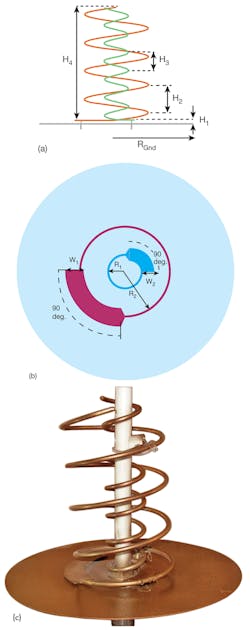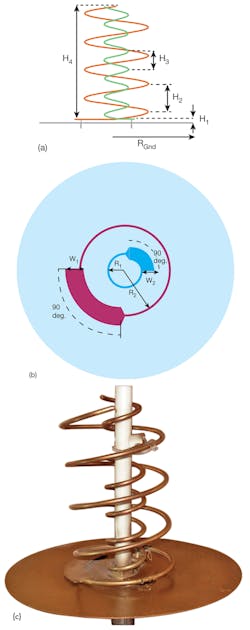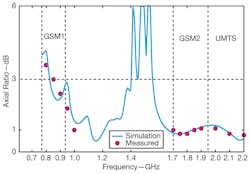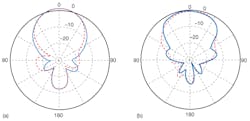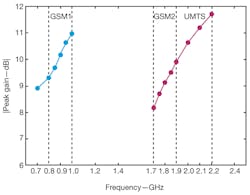Helical Antenna Links GSM/UMTS
This file type includes high resolution graphics and schematics.
Antennas are vital to modern communications systems. But as the number of wireless services grows, the number of antennas across the landscape grows, encouraging the design of more compact antenna structures and multiple-antenna solutions. To meet these needs, the authors have developed a compact, dual-band circularly polarized antenna for cellular Global System for Mobile Communications (GSM) systems. It consists of a pair of helical antennas with the same axial coordinate. The outer helical antenna covers the GSM 900-MHz band while the inner antenna is for GSM-1800 MHz and Universal Mobile Telecommunications System (UMTS) 1900-MHz use. Each antenna employs a different rotation to minimize mutual coupling effects and provide high isolation.
Demands for mobile cellular communications services, including voice, short message service (SMS), and high-speed data, continue to increase with the growing number of cellular communications users. For high-capacity mobile stations (MS), optimum dimensioning or cell planning is needed, requiring placement of microcells within macrocells for maximum coverage.1 Yet, multipath fading is one of the major problems to be overcome in wireless cellular communications networks, and it can be alleviated through space or polarization diversity.2
In space diversity, two receiving antennas at the base transceiver station (BTS) are separated by a distance of minimally 10 times the operating wavelength. In polarization diversity, a pair of dipole or slot antennas with ±45-deg. slant polarization is used. Since these conventional schemes require a large area for installation, the design of a compact, dual-band antenna is more applicable for use in a microcell (e.g., for a portable BTS implemented on a truck).
To reduce multipath fading effects for BTS antennas, the use of single circularly polarized antennas is often preferred instead of conventional space or polarization diversity antennas. There is no need to align a circularly polarized antenna due to the flexible reciprocal orientation between the transmitter and receiver antennas. Therefore, a circularly polarized antenna can be used instead of two separate antennas using space or polarization diversity.
1. These different views show a (a) side view of the proposed dual-band antenna, (b) a top vide of the antenna, and (c) a photograph of the fabricated prototype used in testing.
Although a number of dual-band GSM handset antennas have been reported in the literature,3,4 some research was performed on designing GSM antennas for BTS applications with high-gain performance. In ref. 5, for example, the feed network of a conventional BTS antenna was modified to achieve a broader impedance bandwidth to cover the UMTS 1900-MHz and GSM 1800-MHz bands simultaneously. However, their final antenna structure was not able to cover the lower-frequency GSM 900-MHz band. In ref. 6, a compact printed dipole antenna was proposed for dual-band GSM applications with a ±45-deg. slant polarization. However, the dipole antenna exhibited low gain, making it inappropriate for use in outdoor GSM applications.
In the current report, a compact circular polarized antenna was developed for both GSM and UMTS frequency bands. It consists of two axial-mode helix antennas, closely mounted, with inner and outer antenna sections resonating at 1770 to 1870 MHz and at 890 to 990 MHz, respectively. This configuration reduces the dimensions of the antenna without affecting its performance. The compact antenna was designed to produce stable radiation patterns, making it a viable candidate for microcellular GSM base stations as well as for portable BTS use. In addition to covering both GSM bands, the antenna can also cover UMTS band frequencies.
Figure 1 shows the proposed dual-band helical antenna, with a side view in Fig. 1(a), a top view in Fig. 1(b), and a look at the engineering prototype in Fig. 1(c). Simulation of the antenna was performed with the commercial computer-aided-engineering (CAE) software Ansoft HFSS from Ansys. It is a three-dimensional modeling package based on electromagnetic (EM) simulation.
2. These are measured S11 results for the proposed dual-band helical antenna.
The antenna consists of a pair of helical antennas with the same axial coordinate and different rotation orientation, nested in each other. The inner helical antenna is responsible for GSM 1800 MHz and UMTS 1900 MHz using left-handed circular polarization (LHCP) while the outer antenna is responsible for GSM 900 MHz using right-handed circular polarization (RHCP). By designing two helical antennas with the same axial coordinate, it was possible to achieve the performance of two separate antennas in the physical space of only one. As part of the design of an axial-mode dual-band helical antenna, the circumference of each of the helical antennas was chosen as approximately one wavelength.
The antenna parameters of each helix should be designed to operate at its desired frequency bands with good impedance matching (S11 < -15 dB). Moreover, it is desired that each helical antenna has negligible effects on the other antenna. For that reason, each of the helical antennas is employed with different circular polarization, which should result in the mutual coupling effects between the antennas to be diminished.
3. These are measured S12 results for the proposed dual-band helical antenna.
For good impedance matching between the impedance of the helical antenna (140 Ω) and a conventional 50-Ω 7/16 coaxial connector, a 90-deg. impedance transformer was used. The optimized parameters of the compact, dual-band circularly polarized helical antenna were as follows: H1 = 6; H2 = 52; H3 = 34; H4 = 4*52; Rgnd = 145; R1 = 23; R2 = 50; and W1 = W2 = 18. The inner helical antenna has 6.2 turns while the outer helical antenna has 4 turns. The helical antenna wire diameter is fixed at 3 mm. The fabricated prototype of the proposed antenna is shown in Fig. 1(d).
4. These plots compare the simulated and measured axial ratio values at boresight for the dual-band helical antenna.
Figures 2 and 3 show the measured S-parameters for the proposed dual-band helical antenna. As it can be seen, the antenna’s impedance matching for port 1 (the inner helical antenna) is well below -10 dB in the 1700-to-2200-MHz frequency band allocated to GSM and UMTS use. In addition, the impedance matching of port 2 (the outer helical antenna) is well below -10 dB in the 800-to-1000-MHz frequency band.
Figure 4 shows the simulated and measured results of the antenna’s axial-ratio (AR) performance. The antenna yields good results, with AR of less than 3 dB in the frequency bands of 800 to 1000 MHz and 1700 to 2200 MHz. Figure 5 shows the measured radiation patterns for the proposed dual-band antenna at 950 and 1850 MHz. As can be seen, the antenna delivers stable radiation patterns in both the principle plane of φ = 0 and 90 deg. at both frequencies. Figure 6 shows the peak gain results for the proposed dual-band antenna. The peak gain varies slightly between 9 to 11 dB in the two separate frequency bands.
5. These plots show the measured radiation patterns for the dual-band antenna at (a) 950 MHz and (b) 1800 MHz. The blue solid lines and red dashed lines represent φ = 0 and 90 deg., respectively.
To calculate the coverage area for the proposed dual-band antenna the Okumura-Hata-COST2317 model was used as a channel model. For the sake of calculating the link budget using this antenna, a height of 40 m above the ground was assumed, with a 12-deg. tilt angle with respect to horizontal. These values of tilt and height are common in terrestrial BTS antennas to provide maximum achievable coverage.
6. These plots show the measured peak gains for the dual-band helical antenna in the two frequency bands of interest.
The link budget parameters were considered as follows. The receiver antenna gain and transmitted power for the mobile station were set at 0 dB and +29 dBm, respectively. The average building height of the modeled operating environment, the mobile station height, the street width, and miscellaneous loss (including cable losses and losses within the BTS equipment) were assumed to be 15 m, 1.8 m, 10 m, and 13 dB, respectively. Figure 7 shows the expected coverage area (in km) for the proposed antenna at 950 and 1850 MHz.
7. This plot shows the coverage area of the proposed dual-band antenna assuming a 40-m elevation and tilt angle of 12 deg. from horizontal at (a) 950 MHz and (b) 1850 MHz.
In summary, a new compact dual-band dual-port helical antenna for GSM 900, GSM 1800, and UMTS 1900 MHz was presented. The antenna consists of a pair of helical nested in each other with the same axial coordinate and different rotational orientation. A prototype of the antenna was fabricated and the measured results show that the antenna has good S-parameters, stable radiation patterns, and appropriate peak gain for true dual-band operation. The coverage area of the proposed dual-band circularly polarized antenna, as determined by the Okumura-Hata-COST231 channel model, when the antenna is mounted on a conventional base station, indicates that this antenna design is quite suitable for use in portable and microcellular BTS applications.
This file type includes high resolution graphics and schematics.
Mohammad Bod, Ph.D. Candidate
Ali Mohammad Montarzeri, Research EngineerAli Foudazi, Research Engineer
Mahmoud Ramezani, Research Engineer
Ali Araghi, Research EngineerSatellite Communications Group, Iran Telecommunication Research Center, Tehran, Iran.
Acknowledgments
This work was sponsored by the Satellite Communications Group at the Iran Telecommunication Research Center. The authors would like to express their great gratitude to Dr. M. Shahabadi, Associated Professor of University of Tehran (Tehran, Iran) for his constructive advice.
References
1. G. Eason, B. Noble, and I.N. Sneddon, “On certain integrals of Lipschitz-Hankel type involving products of Bessel functions,” Phil. Transactions of the Royal Society London, Vol. A247, April 1955, pp. 529-551.
2. J.J.A. Lempiainen and J.K. Laiho-Steffens, “The performance of polarization diversity schemes at a base station in small/micro cells at 1800 MHz,” IEEE Transactions on Vehicular Technology, Vol. 47, No. 3, August 1998, pp. 1087-1092.
3. J. Guterman, A.A. Moreira, and C. Peixerio,”Dual-band miniaturized microstrip fractal antenna for a small GSM 1800 + UMTS mobile handset,”Proceedings of the 12th IEEE Mediterranean Electrotechnical Conference (MELECON 2004), Vol. 2, May 12-15, 2004, pp. 499-501.
4. G. Zhou, “A non-uniform pitch dual band helix antenna,” IEEE Antennas and Propagation Society International Symposium, Vol. 1, 2000, pp. 274-277.
5. S.K. Ibrakee and J.M. Rigelsford, “A broadband antenna for GSM1800 and UMTS BTS applications,” Proceedings of the 5th European Conference on Antennas and Propagation (EUCAP), April 11-15, 2011, pp. 511-513.
6. K. Mohammadpour-Aghdam, S. Radiom, G. Vandenbosch, and G. Gielen, “A dual-band printed dipole antenna for indoor GSM-BTS applications,” European Microwave Conference digest, Sept. 29-Oct. 1 2009, pp. 634-637.
7. M. Hata and T. Nagatsu, “Mobile location using signal strength measurements in cellular systems,” IEEE Transactions on Vehicular Technology, Vol. 29, 1980, pp. 245-251.
This file type includes high resolution graphics and schematics.
